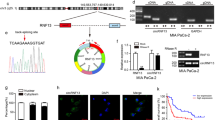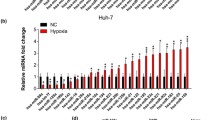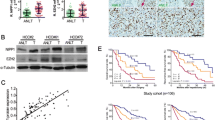Abstract
Hypoxia is one of the hallmarks of solid tumors, especially in hepatocellular carcinoma (HCC). CircRNAs are reported to be tightly connected to hypoxia and also have essential roles in cancer progression. However, many circRNAs implicated in hypoxia-mediated HCC progression are still unclear and require further exploration. In this study, a hypoxia cell model was structured by exposing cells to hypoxia conditions (1% O2) and normoxia conditions (21% O2) as a control. The effects of hypoxia and normoxia on cell viability, migration, invasion, and glycolysis were examined. The expressions of circRNARTN4IP1 under hypoxia were identified. Finally, molecular mechanisms and biological function of circRTN4IP1 were explored. We confirmed that hypoxia treatment facilitated capacities of proliferation, migration, invasion, and glycolysis in tumor cells. Hypoxia induced a significant increase expression of circRTN4IP1 in cells. Functionally, knockdown of circRTN4IP1 inhibited cell malignant progression and glycolysis under hypoxia HCC cells. Mechanistically, HIF1A targeted the promoter region of circRTN4IP1 and positively regulated the expression of circRTN4IP1. In addition, circRTN4IP1 targeted miR-532-5p/G6PC3 axis. In short, hypoxia induced activation of the HIF1A/circRTN4IP1/miR-532-5p/G6PC3 signaling axis, which promoted proliferation, migration, invasion, and glycolysis of HCC cells. This study may reveal a possible mechanism driving the progression of hypoxia HCC, so as to find potential effective candidates for targeting hypoxia microenvironment therapy.
Graphical abstract






Similar content being viewed by others
Data availability
The data used to support the findings of this study are available from the corresponding author upon request.
References
Al Tameemi W, Dale TP, Al-Jumaily RMK, Forsyth NR (2019) Hypoxia-modified cancer cell metabolism. Front Cell Dev Biol 7:4. https://doi.org/10.3389/fcell.2019.00004
Bach DH, Lee SK, Sood AK (2019) Circular RNAs in cancer. Mol Ther Nucleic Acids 16:118–129. https://doi.org/10.1016/j.omtn.2019.02.005
Bao MH, Wong CC (2021) Hypoxia, metabolic reprogramming, and drug resistance in liver cancer. Cells 10. https://doi.org/10.3390/cells10071715
Bernardi G (2021) The “genomic code”: DNA pervasively moulds chromatin structures leaving no room for “junk”. Life (Basel) 11. https://doi.org/10.3390/life11040342
Bray F, Ferlay J, Soerjomataram I, Siegel RL, Torre LA, Jemal A (2018) Global cancer statistics 2018: GLOBOCAN estimates of incidence and mortality worldwide for 36 cancers in 185 countries. CA Cancer J Clin 68:394–424. https://doi.org/10.3322/caac.21492
Chen H, Yang R, Xing L, Wang B, Liu D, Ou X, Deng Y, Jiang R, Chen J (2022) Hypoxia-inducible CircPFKFB4 promotes breast cancer progression by facilitating the CRL4(DDB2) E3 ubiquitin ligase-mediated p27 degradation. Int J Biol Sci 18:3888–3907. https://doi.org/10.7150/ijbs.72842
Chen J, Chen J, Huang J, Li Z, Gong Y, Zou B, Liu X, Ding L, Li P, Zhu Z, Zhang B, Guo H, Cai C, Li J (2019) HIF-2α upregulation mediated by hypoxia promotes NAFLD-HCC progression by activating lipid synthesis via the PI3K-AKT-mTOR pathway. Aging (Albany NY) 11:10839–10860. https://doi.org/10.18632/aging.102488
Chen ZQ, Zuo XL, Cai J, Zhang Y, Han GY, Zhang L, Ding WZ, Wu JD, Wang XH (2023) Hypoxia-associated circPRDM4 promotes immune escape via HIF-1α regulation of PD-L1 in hepatocellular carcinoma. Exp Hematol Oncol 12:17. https://doi.org/10.1186/s40164-023-00378-2
Du Q, Han J, Gao S, Zhang S, Pan Y (2020) Hypoxia-induced circular RNA hsa_circ_0008450 accelerates hepatocellular cancer progression via the miR-431/AKAP1 axis. Oncol Lett 20:388. https://doi.org/10.3892/ol.2020.12251
Feng D, Xu Y, Hu J, Zhang S, Li M, Xu L (2020) A novel circular RNA, hsa-circ-0000211, promotes lung adenocarcinoma migration and invasion through sponging of hsa-miR-622 and modulating HIF1-α expression. Biochem Biophys Res Commun 521:395–401. https://doi.org/10.1016/j.bbrc.2019.10.134
Fu Z, Zhang P, Zhang R, Zhang B, Xiang S, Zhang Y, Luo Z, Huang C (2023) Novel hypoxia-induced HIF1α-circTDRD3-positive feedback loop promotes the growth and metastasis of colorectal cancer. Oncogene 42:238–252. https://doi.org/10.1038/s41388-022-02548-8
Gao L, Dou ZC, Ren WH, Li SM, Liang X, Zhi KQ (2019) CircCDR1as upregulates autophagy under hypoxia to promote tumor cell survival via AKT/ERK(½)/mTOR signaling pathways in oral squamous cell carcinomas. Cell Death Dis 10:745. https://doi.org/10.1038/s41419-019-1971-9
Ge SX (2017) Exploratory bioinformatics investigation reveals importance of “junk” DNA in early embryo development. BMC Genom 18:200. https://doi.org/10.1186/s12864-017-3566-0
Hammarlund EU, Flashman E, Mohlin S, Licausi F (2020) Oxygen-sensing mechanisms across eukaryotic kingdoms and their roles in complex multicellularity. Science 370. https://doi.org/10.1126/science.aba3512
Huang C, Yu W, Wang Q, Huang T, Ding Y (2021) CircANTXR1 contributes to the malignant progression of hepatocellular carcinoma by promoting proliferation and metastasis. J Hepatocell Carcinoma 8:1339–1353. https://doi.org/10.2147/jhc.S317256
Huang D, Li C, Zhang H (2014) Hypoxia and cancer cell metabolism. Acta Biochim Biophys Sin Shanghai 46:214–219. https://doi.org/10.1093/abbs/gmt148
Huang Q, Yang J, Goh RMW, You M, Wang L, Ma Z (2022) Hypoxia-induced circRNAs in human diseases: from mechanisms to potential applications. Cells 11. https://doi.org/10.3390/cells11091381
Huang R, Zong X (2017) Aberrant cancer metabolism in epithelial-mesenchymal transition and cancer metastasis: mechanisms in cancer progression. Crit Rev Oncol Hematol 115:13–22. https://doi.org/10.1016/j.critrevonc.2017.04.005
Ivan M, Fishel ML, Tudoran OM, Pollok KE, Wu X, Smith PJ (2022) Hypoxia signaling: challenges and opportunities for cancer therapy. Semin Cancer Biol 85:185–195. https://doi.org/10.1016/j.semcancer.2021.10.002
Janji B, Chouaib S (2022) The promise of targeting hypoxia to improve cancer immunotherapy: mirage or reality? Front Immunol 13:880810. https://doi.org/10.3389/fimmu.2022.880810
Jiao B, Liu S, Zhao H, Zhuang Y, Ma S, Lin C, Hu J, Liu X (2022) Hypoxia-responsive circRNAs: a novel but important participant in non-coding RNAs ushered toward tumor hypoxia. Cell Death Dis 13:666. https://doi.org/10.1038/s41419-022-05114-y
Jin Y, Che X, Qu X, Li X, Lu W, Wu J, Wang Y, Hou K, Li C, Zhang X, Zhou J, Liu Y (2020) CircHIPK3 promotes metastasis of gastric cancer via miR-653-5p/miR-338-3p-NRP1 axis under a long-term hypoxic microenvironment. Front Oncol 10:1612. https://doi.org/10.3389/fonc.2020.01612
Jing X, Yang F, Shao C, Wei K, Xie M, Shen H, Shu Y (2019) Role of hypoxia in cancer therapy by regulating the tumor microenvironment. Mol Cancer 18:157. https://doi.org/10.1186/s12943-019-1089-9
Lai Q, Li W, Wang H, Xu S, Deng Z (2022) Emerging role of circRNAs in cancer under hypoxia. Oncol Lett 24:372. https://doi.org/10.3892/ol.2022.13492
Lau KW, Tian YM, Raval RR, Ratcliffe PJ, Pugh CW (2007) Target gene selectivity of hypoxia-inducible factor-alpha in renal cancer cells is conveyed by post-DNA-binding mechanisms. Br J Cancer 96:1284–1292. https://doi.org/10.1038/sj.bjc.6603675
Li Q, Ni Y, Zhang L, Jiang R, Xu J, Yang H, Hu Y, Qiu J, Pu L, Tang J, Wang X (2021) HIF-1α-induced expression of m6A reader YTHDF1 drives hypoxia-induced autophagy and malignancy of hepatocellular carcinoma by promoting ATG2A and ATG14 translation. Signal Transduct Target Ther 6:76. https://doi.org/10.1038/s41392-020-00453-8
Li Q, Pan X, Zhu D, Deng Z, Jiang R, Wang X (2019) Circular RNA MAT2B promotes glycolysis and malignancy of hepatocellular carcinoma through the miR-338-3p/PKM2 axis under hypoxic stress. Hepatology 70:1298–1316. https://doi.org/10.1002/hep.30671
Maldonado V, Melendez-Zajgla J (2022) The role of hypoxia-associated long non-coding RNAs in breast cancer. Cells 11. https://doi.org/10.3390/cells11101679
Ojha R, Nandani R, Chatterjee N, Prajapati VK (2018) Emerging role of circular RNAs as potential biomarkers for the diagnosis of human diseases. Adv Exp Med Biol 1087:141–157. https://doi.org/10.1007/978-981-13-1426-1_12
Ouyang X, Yao L, Liu G, Liu S, Gong L, Xiao Y (2021) Loss of androgen receptor promotes HCC invasion and metastasis via activating circ-LNPEP/miR-532-3p/RAB9A signal under hypoxia. Biochem Biophys Res Commun 557:26–32. https://doi.org/10.1016/j.bbrc.2021.02.120
Rankin EB, Giaccia AJ (2016) Hypoxic control of metastasis. Science 352:175–180. https://doi.org/10.1126/science.aaf4405
Schödel J, Oikonomopoulos S, Ragoussis J, Pugh CW, Ratcliffe PJ, Mole DR (2011) High-resolution genome-wide mapping of HIF-binding sites by ChIP-seq. Blood 117:e207–e217. https://doi.org/10.1182/blood-2010-10-314427
Schödel J, Ratcliffe PJ (2019) Mechanisms of hypoxia signalling: new implications for nephrology. Nat Rev Nephrol 15:641–659. https://doi.org/10.1038/s41581-019-0182-z
Schofield CJ, Ratcliffe PJ (2004) Oxygen sensing by HIF hydroxylases. Nat Rev Mol Cell Biol 5:343–354. https://doi.org/10.1038/nrm1366
Semenza GL (2010) HIF-1: upstream and downstream of cancer metabolism. Curr Opin Genet Dev 20:51–56. https://doi.org/10.1016/j.gde.2009.10.009
Semenza GL (2013) HIF-1 mediates metabolic responses to intratumoral hypoxia and oncogenic mutations. J Clin Invest 123:3664–3671. https://doi.org/10.1172/jci67230
Shi R, Liao C, Zhang Q (2021) Hypoxia-driven effects in cancer: characterization, mechanisms, and therapeutic implications. Cells 10. https://doi.org/10.3390/cells10030678
Siegel RL, Miller KD, Fuchs HE, Jemal A (2021) Cancer statistics, 2021. CA Cancer J Clin 71:7–33. https://doi.org/10.3322/caac.21654
Singleton DC, Macann A, Wilson WR (2021) Therapeutic targeting of the hypoxic tumour microenvironment. Nat Rev Clin Oncol 18:751–772. https://doi.org/10.1038/s41571-021-00539-4
Tan Y, Du B, Zhan Y, Wang K, Wang X, Chen B, Wei X, Xiao J (2019) Antitumor effects of circ-EPHB4 in hepatocellular carcinoma via inhibition of HIF-1α. Mol Carcinog 58:875–886. https://doi.org/10.1002/mc.22976
Tang J, Wang R, Tang R, Gu P, Han J, Huang W (2022) CircRTN4IP1 regulates the malignant progression of intrahepatic cholangiocarcinoma by sponging miR-541-5p to induce HIF1A production. Pathol Res Pract 230:153732. https://doi.org/10.1016/j.prp.2021.153732
Thomson DW, Dinger ME (2016) Endogenous microRNA sponges: evidence and controversy. Nat Rev Genet 17:272–283. https://doi.org/10.1038/nrg.2016.20
Vaupel P, Mayer A (2007) Hypoxia in cancer: significance and impact on clinical outcome. Cancer Metastasis Rev 26:225–239. https://doi.org/10.1007/s10555-007-9055-1
Xing X, Liang D, Huang Y, Zeng Y, Han X, Liu X, Liu J (2016) The application of proteomics in different aspects of hepatocellular carcinoma research. J Proteome 145:70–80. https://doi.org/10.1016/j.jprot.2016.03.050
Yang H, Hu Y, Weng M, Liu X, Wan P, Hu Y, Ma M, Zhang Y, Xia H, Lv K (2022) Hypoxia inducible lncRNA-CBSLR modulates ferroptosis through m6A-YTHDF2-dependent modulation of CBS in gastric cancer. J Adv Res 37:91–106. https://doi.org/10.1016/j.jare.2021.10.001
Yang K, Zhang J, Bao C (2021) Exosomal circEIF3K from cancer-associated fibroblast promotes colorectal cancer (CRC) progression via miR-214/PD-L1 axis. BMC Cancer 21:933. https://doi.org/10.1186/s12885-021-08669-9
Yang W, Liu Y, Gao R, Xiu Z, Sun T (2019) Knockdown of cZNF292 suppressed hypoxic human hepatoma SMMC7721 cell proliferation, vasculogenic mimicry, and radioresistance. Cell Signal 60:122–135. https://doi.org/10.1016/j.cellsig.2019.04.011
Zeng Z, Zhao Y, Chen Q, Zhu S, Niu Y, Ye Z, Hu P, Chen D, Xu P, Chen J, Hu C, Hu Y, Xu F, Tang J, Wang F, Han S, Huang M, Wang C, Zhao G (2021) Hypoxic exosomal HIF-1α-stabilizing circZNF91 promotes chemoresistance of normoxic pancreatic cancer cells via enhancing glycolysis. Oncogene 40:5505–5517. https://doi.org/10.1038/s41388-021-01960-w
Zhao Q, Zhu Z, Xiao W, Zong G, Wang C, Jiang W, Li K, Shen J, Guo X, Cui J, Guo L, Wan R (2022) Hypoxia-induced circRNF13 promotes the progression and glycolysis of pancreatic cancer. Exp Mol Med 54:1940–1954. https://doi.org/10.1038/s12276-022-00877-y
Zhao S, Li B, Zhao R, Pan Z, Zhang S, Qiu W, Guo Q, Qi Y, Gao Z, Fan Y, Xu H, Li M, Zhang J, Wang H, Xu J, Wang S, Wang Q, Qiu J, Deng L et al (2023) Hypoxia-induced circADAMTS6 in a TDP43-dependent manner accelerates glioblastoma progression via ANXA2/NF-κB pathway. Oncogene 42:138–153. https://doi.org/10.1038/s41388-022-02542-0
Zheng XB, Zhang M, Xu MQ (2017) Detection and characterization of ciRS-7: a potential promoter of the development of cancer. Neoplasma 64:321–328. https://doi.org/10.4149/neo_2017_301
Author information
Authors and Affiliations
Contributions
XY and CL designed the study, and drafted the manuscript. CY collected the clinical data and processed statistical data. QZ analyzed and interpreted the data. GL and YD partly contributed to the experiment. CY and QZ designed, supervised the study, and revised the manuscript. All authors read and approved the final version of the manuscript.
Corresponding authors
Ethics declarations
Ethics approval
Not applicable.
Conflict of interest
The authors declare no competing interests.
Additional information
Publisher’s note
Springer Nature remains neutral with regard to jurisdictional claims in published maps and institutional affiliations.
Rights and permissions
Springer Nature or its licensor (e.g. a society or other partner) holds exclusive rights to this article under a publishing agreement with the author(s) or other rightsholder(s); author self-archiving of the accepted manuscript version of this article is solely governed by the terms of such publishing agreement and applicable law.
About this article
Cite this article
Yang, X., Lou, C., Zhang, Q. et al. Hypoxia-induced circRTN4IP1 promotes progression and glycolysis of hepatocellular carcinoma cells. Funct Integr Genomics 23, 339 (2023). https://doi.org/10.1007/s10142-023-01256-0
Received:
Revised:
Accepted:
Published:
DOI: https://doi.org/10.1007/s10142-023-01256-0




